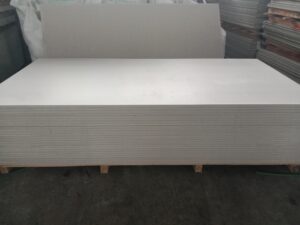 High-density raw/prime fiber cement boards are unpainted, untextured panels that represent the material’s premium, most durable form. They are valued for their superior structural properties and are often used in commercial or modern architectural facades.
High-density raw/prime fiber cement boards are unpainted, untextured panels that represent the material’s premium, most durable form. They are valued for their superior structural properties and are often used in commercial or modern architectural facades.
Key Characteristics and Specifications
“Raw” or “prime” fiber cement board refers to the natural, untreated state of the material as it comes out of the autoclave (the high-pressure steam-curing process), typically with a natural light gray to dark gray color. “High-density” is a classification based on the mass per unit volume.
| Density Classification | Range (g/cm³) | Range (kg/m³) | Typical Application |
| High Density (HD) | 1.4 – 1.7 g/cm³ | 1,400 – 1,700 kg/m³ | Exterior Facades, Structural Sheathing, Flooring, High-Impact Areas |
| Medium Density (MD) | 1.2 – 1.5 g/cm³ | 1,200 – 1,500 kg/m³ | Interior Walls, Commercial Partitions |
| Low Density (LD) | 0.9 – 1.2 g/cm³ | 900 – 1,200 kg/m³ | Ceilings, Non-load-bearing Partitions |
- Composition: High-density fiber cement is made from a blend of cellulose fiber, cement, quartz sand, and water.
- Manufacturing: To achieve high density, the material is generally pressed using a high-tonnage hydraulic press before or during the high-pressure steam-curing process (autoclaving). This makes the board much more compact.
- Strength & Durability: Due to their greater density, these boards exhibit superior bending strength, impact resistance, and water resistance. They are less prone to movement (expansion/contraction) from moisture absorption compared to lower-density types.
- Aesthetics: The raw boards have a natural, often mottled, concrete-like appearance. They can be left exposed for an industrial/minimalist look (often sealed with a clear, matte, or satin finish) or treated/painted on-site.
Common Applications of HD Raw/Prime Boards
The enhanced strength and weather resistance of high-density raw fiber cement make it suitable for demanding applications:
- Exterior Cladding/Façades: Used in rainscreen systems for commercial buildings and modern residential architecture where a raw, durable, concrete-like finish is desired.
- Substrates: Used as a durable, non-combustible substrate for thin-set stone, tile, or specialized stucco systems.
- Flooring: Thicker HD boards (≥18mm) are used for heavy-duty industrial flooring or as high-strength decking/sub-flooring (e.g., in steel-structure buildings).
- Fire-Rated Construction: Excellent non-combustibility (A-class/A1) makes them ideal for fire-rated walls, partitions, and ductwork enclosures.
- Wet Areas: Their high impermeability and resistance to moisture movement make them superior for use in high-humidity or wet interior areas like bathrooms and kitchens before tiling.
SEP
2025
